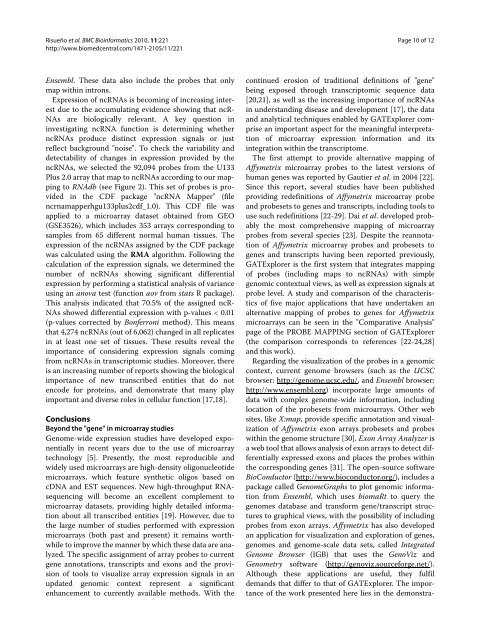Alberto Risueño Pérez - Gredos - Universidad de Salamanca
Alberto Risueño Pérez - Gredos - Universidad de Salamanca
Alberto Risueño Pérez - Gredos - Universidad de Salamanca
Create successful ePaper yourself
Turn your PDF publications into a flip-book with our unique Google optimized e-Paper software.
<strong>Risueño</strong> et al. BMC Bioinformatics 2010, 11:221<br />
http://www.biomedcentral.com/1471-2105/11/221<br />
Ensembl. These data also inclu<strong>de</strong> the probes that only<br />
map within introns.<br />
Expression of ncRNAs is becoming of increasing interest<br />
due to the accumulating evi<strong>de</strong>nce showing that ncR-<br />
NAs are biologically relevant. A key question in<br />
investigating ncRNA function is <strong>de</strong>termining whether<br />
ncRNAs produce distinct expression signals or just<br />
reflect background "noise". To check the variability and<br />
<strong>de</strong>tectability of changes in expression provi<strong>de</strong>d by the<br />
ncRNAs, we selected the 92,094 probes from the U133<br />
Plus 2.0 array that map to ncRNAs according to our mapping<br />
to RNAdb (see Figure 2). This set of probes is provi<strong>de</strong>d<br />
in the CDF package "ncRNA Mapper" (file<br />
ncrnamapperhgu133plus2cdf_1.0). This CDF file was<br />
applied to a microarray dataset obtained from GEO<br />
(GSE3526), which inclu<strong>de</strong>s 353 arrays corresponding to<br />
samples from 65 different normal human tissues. The<br />
expression of the ncRNAs assigned by the CDF package<br />
was calculated using the RMA algorithm. Following the<br />
calculation of the expression signals, we <strong>de</strong>termined the<br />
number of ncRNAs showing significant differential<br />
expression by performing a statistical analysis of variance<br />
using an anova test (function aov from stats R package).<br />
This analysis indicated that 70.5% of the assigned ncR-<br />
NAs showed differential expression with p-values < 0.01<br />
(p-values corrected by Bonferroni method). This means<br />
that 4,274 ncRNAs (out of 6,062) changed in all replicates<br />
in at least one set of tissues. These results reveal the<br />
importance of consi<strong>de</strong>ring expression signals coming<br />
from ncRNAs in transcriptomic studies. Moreover, there<br />
is an increasing number of reports showing the biological<br />
importance of new transcribed entities that do not<br />
enco<strong>de</strong> for proteins, and <strong>de</strong>monstrate that many play<br />
important and diverse roles in cellular function [17,18].<br />
Conclusions<br />
Beyond the "gene" in microarray studies<br />
Genome-wi<strong>de</strong> expression studies have <strong>de</strong>veloped exponentially<br />
in recent years due to the use of microarray<br />
technology [5]. Presently, the most reproducible and<br />
wi<strong>de</strong>ly used microarrays are high-<strong>de</strong>nsity oligonucleoti<strong>de</strong><br />
microarrays, which feature synthetic oligos based on<br />
cDNA and EST sequences. New high-throughput RNAsequencing<br />
will become an excellent complement to<br />
microarray datasets, providing highly <strong>de</strong>tailed information<br />
about all transcribed entities [19]. However, due to<br />
the large number of studies performed with expression<br />
microarrays (both past and present) it remains worthwhile<br />
to improve the manner by which these data are analyzed.<br />
The specific assignment of array probes to current<br />
gene annotations, transcripts and exons and the provision<br />
of tools to visualize array expression signals in an<br />
updated genomic context represent a significant<br />
enhancement to currently available methods. With the<br />
Page 10 of 12<br />
continued erosion of traditional <strong>de</strong>finitions of "gene"<br />
being exposed through transcriptomic sequence data<br />
[20,21], as well as the increasing importance of ncRNAs<br />
in un<strong>de</strong>rstanding disease and <strong>de</strong>velopment [17], the data<br />
and analytical techniques enabled by GATExplorer comprise<br />
an important aspect for the meaningful interpretation<br />
of microarray expression information and its<br />
integration within the transcriptome.<br />
The first attempt to provi<strong>de</strong> alternative mapping of<br />
Affymetrix microarray probes to the latest versions of<br />
human genes was reported by Gautier et al. in 2004 [22].<br />
Since this report, several studies have been published<br />
providing re<strong>de</strong>finitions of Affymetrix microarray probe<br />
and probesets to genes and transcripts, including tools to<br />
use such re<strong>de</strong>finitions [22-29]. Dai et al. <strong>de</strong>veloped probably<br />
the most comprehensive mapping of microarray<br />
probes from several species [23]. Despite the reannotation<br />
of Affymetrix microarray probes and probesets to<br />
genes and transcripts having been reported previously,<br />
GATExplorer is the first system that integrates mapping<br />
of probes (including maps to ncRNAs) with simple<br />
genomic contextual views, as well as expression signals at<br />
probe level. A study and comparison of the characteristics<br />
of five major applications that have un<strong>de</strong>rtaken an<br />
alternative mapping of probes to genes for Affymetrix<br />
microarrays can be seen in the "Comparative Analysis"<br />
page of the PROBE MAPPING section of GATExplorer<br />
(the comparison corresponds to references [22-24,28]<br />
and this work).<br />
Regarding the visualization of the probes in a genomic<br />
context, current genome browsers (such as the UCSC<br />
browser: http://genome.ucsc.edu/, and Ensembl browser:<br />
http://www.ensembl.org) incorporate large amounts of<br />
data with complex genome-wi<strong>de</strong> information, including<br />
location of the probesets from microarrays. Other web<br />
sites, like X:map, provi<strong>de</strong> specific annotation and visualization<br />
of Affymetrix exon arrays probesets and probes<br />
within the genome structure [30]. Exon Array Analyzer is<br />
a web tool that allows analysis of exon arrays to <strong>de</strong>tect differentially<br />
expressed exons and places the probes within<br />
the corresponding genes [31]. The open-source software<br />
BioConductor (http://www.bioconductor.org/), inclu<strong>de</strong>s a<br />
package called GenomeGraphs to plot genomic information<br />
from Ensembl, which uses biomaRt to query the<br />
genomes database and transform gene/transcript structures<br />
to graphical views, with the possibility of including<br />
probes from exon arrays. Affymetrix has also <strong>de</strong>veloped<br />
an application for visualization and exploration of genes,<br />
genomes and genome-scale data sets, called Integrated<br />
Genome Browser (IGB) that uses the GenoViz and<br />
Genometry software (http://genoviz.sourceforge.net/).<br />
Although these applications are useful, they fulfil<br />
<strong>de</strong>mands that differ to that of GATExplorer. The importance<br />
of the work presented here lies in the <strong>de</strong>monstra-
















